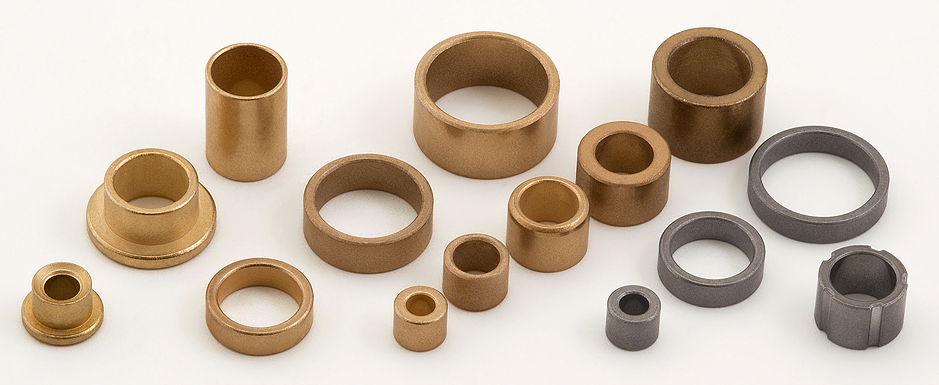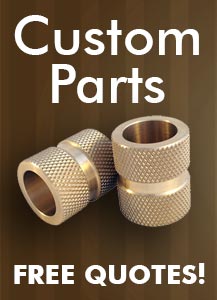A question we get asked often at our office is what the difference is between cast bronze bushings and oil impregnated bronze bushings. These 2 types of bronze bushings are very different from each other, both with unique attributes and limitations. Hopefully this post will help clear up the confusion and help you choose the right bronze bushing for your specific application. The differences between the cast and oil impregnated bronze bushings are mostly due to the different manufacturing processes that are used to manufacture each type. The cast bronze bushings are a machined part from usually continuously cast bronze stock. While the oil impregnated bronze bushings are manufactured via the P/M (Powdered Metallurgy) Process and are pressed from a powder and sintered into a hardened part. There are advantages and disadvantages with both processes.
The P/M process was developed as a more cost effect method of producing metal parts. This process is an economical, high production method for making parts exactly to or close to final dimensions. With little or no machining operations required. Due to their porosity, they may be impregnated with oil or plastic. The first modern use for powder metallurgy parts came in the 1920’s with the development of the self-lubricating bearings and bronze bearings used in automobiles. This processes involves pressing metal powder into dies with extreme pressure to form a shaped product. This pressed part is sent through a furnace at temperatures below the melting point of the metal to bond the particles without changing the shape of the part. The sintering process also increases part strength and controls the porosity of the part. Although the finish parts look solid, they actually consist of small interconnected capillaries, which cause the parts to be approximately 25% porous. During sintering the compacted parts obtain their mechanical strength. These parts are followed with a process to re-size the parts and then finally vacuum impregnated with oil.

The advantages of this method are lower scrap loss and more efficient manufacturing at high volumes. Also due to the impregnation of oil these bronze bushings are self lubricating. The disadvantages are in the mechanical strength limitations that the P/M process causes. The oil impregnated bronze bushing is ideal for applications where the loads are moderate to low but can accommodate greater velocity requirements. These parts are also maintenance free and do not require additional lubrication. Another disadvantage is that these parts cannot be used in applications where the impregnated oil might contaminate something. These parts are full of oil and this oil will contaminate anything that comes in contact with it.
The cast bronze bushing begins with the casting of the bronze alloy bar stock. For our standard CB’s (Cast Bronze) bushings this alloy is C93200 SAE 660 Bearing Bronze. This alloy is manufactured through the advance casting method called continuous casting. This method yields a metal with a finer grain structure and stronger mechanical properties. The cast bronze bar stock is then machined through a CNC lathe. This process removes additional stock from the cast bar stock and machines the finished bushing. This process of removing the metal causes a scrap loss and is a slower method than the P/M process. These factors are the reason while the cast bronze bushings will generally be more expensive than the P/M bronze bushings. These cast bronze bushings also require additional lubrication. The advantages of the cast bronze bushings are the ability to withstand greater load requirements than the sintered bronze bushings. The cast bronze bushings are utilized in applications where the powdered metal product cannot hold up.
As you can see there are some major differences between the cast and oil impregnated bronze bushings. If you are not sure which one is appropriate for your application, feel free to contact us for application advice.

